In the competitive world of retail, creating a unique and engaging shopping environment is essential. One innovative approach that has gained popularity is the shop-in-shop design. This concept allows brands to establish mini-stores within larger retail spaces, enhancing customer experience and driving sales. In this article, we’ll explore the top trends in shop-in-shop design that can help retailers stand out.
1. The Rise of Collaborative Spaces
Emphasizing Partnerships
One of the most significant trends in shop-in-shop design is the focus on collaboration. Retailers are increasingly partnering with complementary brands to create shared spaces. This not only diversifies the product offering but also attracts a broader customer base. For instance, a beauty brand might share space with a fashion retailer, allowing customers to shop for both cosmetics and clothing in one visit.
2. Immersive Customer Experiences
Engaging the Senses
Creating an immersive experience is key to capturing customer attention. Shop-in-shop designs now focus on sensory elements—like lighting, sounds, and textures—to create a memorable shopping environment. For example, using dynamic displays and interactive screens can engage customers, encouraging them to spend more time exploring the space.
3. Sustainability in Design
Eco-Friendly Materials
Sustainability is not just a trend; it’s becoming a necessity. Retailers are increasingly opting for eco-friendly materials and designs in their shop-in-shop setups. This includes using reclaimed wood, recyclable displays, and energy-efficient lighting. By promoting sustainability, brands can appeal to environmentally conscious consumers while also enhancing their brand image.
4. Modular and Flexible Designs
Adapting to Change
The retail landscape is constantly evolving, and flexibility in design is crucial. Modular shop-in-shop setups allow brands to easily adapt their space as needed. This could involve changing product displays, adjusting layouts for seasonal promotions, or even rebranding efforts. Flexibility ensures that retailers can respond to trends and customer preferences efficiently.
5. Technology Integration
Enhancing the Shopping Experience
Integrating technology into shop-in-shop design is a trend that continues to gain momentum. Retailers are using augmented reality (AR), virtual reality (VR), and mobile apps to enhance the shopping experience. For example, AR can help customers visualize how products will look in their homes, while mobile apps can provide personalized recommendations based on shopping habits.
6. Personalization and Customization
Tailoring the Experience
Personalization is key to modern retail success. Shop-in-shop designs are increasingly focused on creating customized experiences for customers. This might include tailored product offerings based on customer demographics or personalized shopping assistants that guide customers through their purchasing journey.
7. Focus on Community Engagement
Building Connections
Another emerging trend in shop-in-shop design is the emphasis on community engagement. Retailers are creating spaces that encourage interaction and socialization. This can be achieved through hosting events, workshops, or pop-up shops that bring the community together and foster brand loyalty.
Conclusion
The shop-in-shop design trend is transforming the retail landscape by creating unique, engaging spaces that cater to the modern consumer. By incorporating collaborative partnerships, immersive experiences, sustainable practices, flexibility, technology, personalization, and community engagement, retailers can differentiate themselves and enhance the shopping experience. Embracing these trends will not only attract customers but also build lasting brand loyalty in an ever-changing market.


